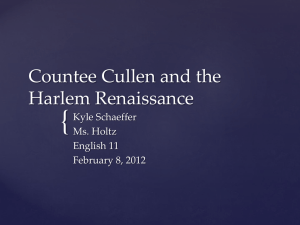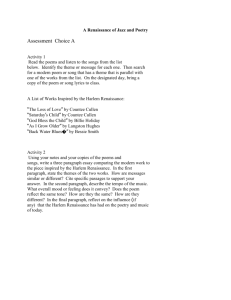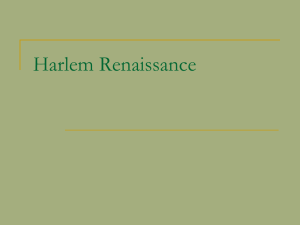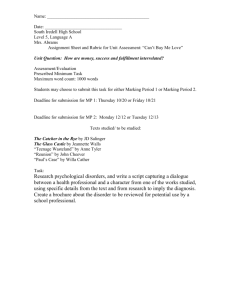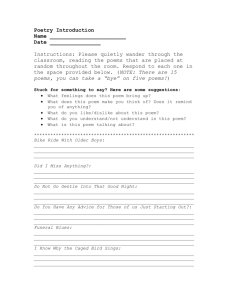Harlem Renaissance Poetry Project: High School Literature
advertisement
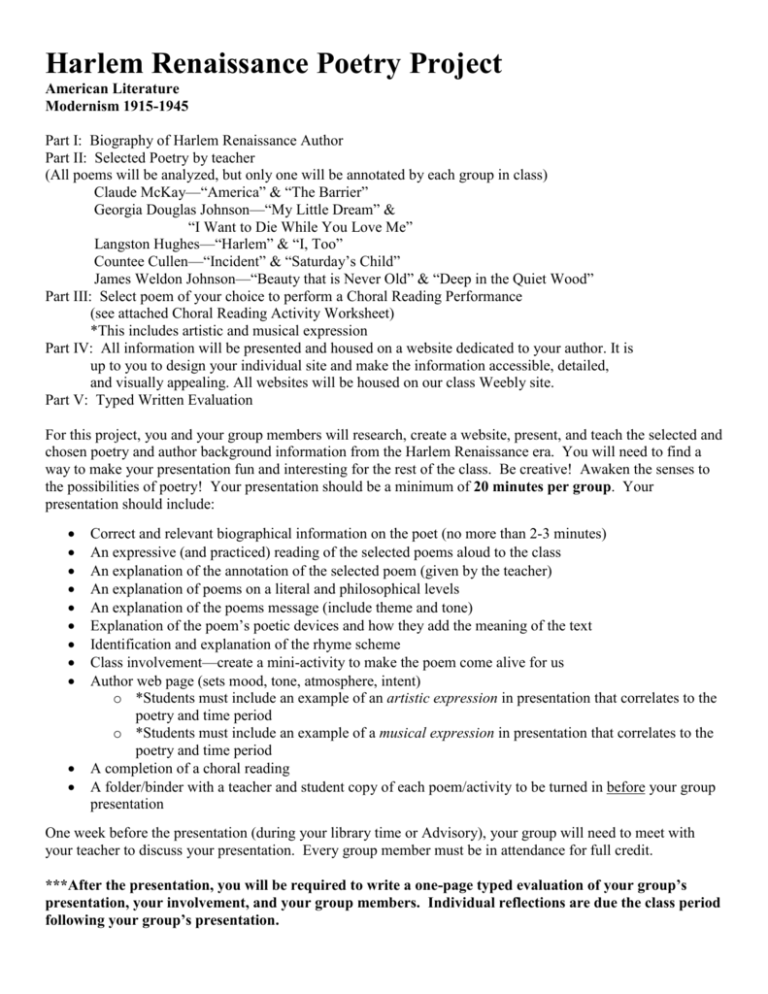
Harlem Renaissance Poetry Project American Literature Modernism 1915-1945 Part I: Biography of Harlem Renaissance Author Part II: Selected Poetry by teacher (All poems will be analyzed, but only one will be annotated by each group in class) Claude McKay—“America” & “The Barrier” Georgia Douglas Johnson—“My Little Dream” & “I Want to Die While You Love Me” Langston Hughes—“Harlem” & “I, Too” Countee Cullen—“Incident” & “Saturday’s Child” James Weldon Johnson—“Beauty that is Never Old” & “Deep in the Quiet Wood” Part III: Select poem of your choice to perform a Choral Reading Performance (see attached Choral Reading Activity Worksheet) *This includes artistic and musical expression Part IV: All information will be presented and housed on a website dedicated to your author. It is up to you to design your individual site and make the information accessible, detailed, and visually appealing. All websites will be housed on our class Weebly site. Part V: Typed Written Evaluation For this project, you and your group members will research, create a website, present, and teach the selected and chosen poetry and author background information from the Harlem Renaissance era. You will need to find a way to make your presentation fun and interesting for the rest of the class. Be creative! Awaken the senses to the possibilities of poetry! Your presentation should be a minimum of 20 minutes per group. Your presentation should include: Correct and relevant biographical information on the poet (no more than 2-3 minutes) An expressive (and practiced) reading of the selected poems aloud to the class An explanation of the annotation of the selected poem (given by the teacher) An explanation of poems on a literal and philosophical levels An explanation of the poems message (include theme and tone) Explanation of the poem’s poetic devices and how they add the meaning of the text Identification and explanation of the rhyme scheme Class involvement—create a mini-activity to make the poem come alive for us Author web page (sets mood, tone, atmosphere, intent) o *Students must include an example of an artistic expression in presentation that correlates to the poetry and time period o *Students must include an example of a musical expression in presentation that correlates to the poetry and time period A completion of a choral reading A folder/binder with a teacher and student copy of each poem/activity to be turned in before your group presentation One week before the presentation (during your library time or Advisory), your group will need to meet with your teacher to discuss your presentation. Every group member must be in attendance for full credit. ***After the presentation, you will be required to write a one-page typed evaluation of your group’s presentation, your involvement, and your group members. Individual reflections are due the class period following your group’s presentation. CHORAL READING ACTIVITY SHEET Please consider the following items when planning a choral reading: 1. The overall meaning or message of the selection and author intent. 2. How you wish to convey the meaning: (forcefully, gently, matter-of-factly, humorously, dramatically, satirically, repetitively, rhythmically, etc.) 3. Which part of the selection should be read by: (everyone, a solo voice, a duet, a trio, girls, boys, high voices, low voices, etc.) 4. Which part of the selection should be read: (slowly, quickly, moderately, choppily, smoothly, variation of voices, variation of pitch/volume, changing tone, etc.) 5. Each group must include ART in the background from the corresponding time period and needs to reflect the tone, mood, atmosphere, setting, and intent of the choral reading. 6. Each group must include MUSIC in the background from the corresponding time period and needs to reflect the tone, mood, atmosphere, setting, and intent of the choral reading. 7. You may add sound effects. 8. You may use special lighting effects. 9. You may add movements, actions, gestures, and/or dance moves. 10. You may infuse singing or rapping to the piece. 11. You may use props, decorations, or audience members. 12. You may use costumes or other thematic elements. 13. The possibilities are endless so……. Have fun and Be CrEaTiVe!!!!! 14. Remember that practice makes perfect, so practice! Each performance will be allotted points with this in mind. Harlem Renaissance Poetry Project Presentation Evaluation Grading: Pre-presentation meeting: Preparedness of ideas and material Timeliness to meeting Dependability/responsibility of team members Presentation: Accuracy of background information on poet Delivery of poems Validity and depth of analysis and interpretation All poems will be analyzed and one poem will be annotated with the class Accuracy of the poetic devices Creativity of activity and presentation as a whole Use and appearance of interactive web page Incorporation of artistic expression Incorporation of musical expression Choral Reading Activity Group folder/binder with related info (teacher & student copy) Individual Paper Evaluation: One page typed, double spaced, TNR font, 12 pts. Depth of thought Effort applied to writing Evaluation of teamwork My group’s author is: ________________________________________________________________________ Our presentation due date is: __________________________________________________________________ The date of our meeting is: ___________________________________________________________________ My group members are: ______________________________________________________________________ __________________________________________________________________________________________ __________________________________________________________________________________________ My responsibilities are: ______________________________________________________________________ __________________________________________________________________________________________ __________________________________________________________________________________________ __________________________________________________________________________________________ __________________________________________________________________________________________ __________________________________________________________________________________________ __________________________________________________________________________________________ __________________________________________________________________________________________ HARLEM RENAISSANCE POETRY GROUP PROJECT You and your group members have been assigned an influential American poet, specifically from the Harlem Renaissance. The Harlem Renaissance was a time of great cultural creativity in the African American community. It impacted the entire American popular culture during the 1920’s and continued for generations to come, including ours. Your group is required to complete the following components for your project: 1. The project (hard copy-in a folder) must be turned in to teacher BEFORE the presentation. 2. You must create a website dedicated to your author 3. You must include a detailed author biography. 4. You must annotate one of the required poems from your author and discuss the literal and philosophical meaning of the other. 5. You must perform a Choral Reading of one of the poems, or you can include a third poem to present in this manner (refer to the Choral Reading Sheet for ideas/suggestions). 6. Class Activity (Creative/Interactive/Grade Appropriate) FILL OUT AND ATTACH TO THE RUBRIC GROUP MEMBERS NAMES: ___________________________________________________________________________________ ___________________________________________________________________________________________________________ AUTHOR: ___________________________________________________________ WEBSITE 15 PTS ______ *Must include: Author Bio, Required Annotated Poem, Second Poem Analysis, and Poem of Choice/Choral Reading Poem *Well-organized and interactive *Colorful/Creative *Include Art, Music, Photographs of Author *Legible (easy to read by audience) AUTHOR BIOGRAPHY *Detailed *Accurate 5 PTS ______ ANNOTATION & ANALYSIS *Thorough/Detailed *Logical Flow/Consistency *Thesis Statements *Literal/Figurative *Literary Elements *Quotes/Supports *Easy for class to understand 25 PTS ______ CHORAL READING *Unique/Creative *Music and Art included *Representative of poem 25 PTS ______ CLASS ACTIVITY *Engaging *Age/Grade Level Appropriate 5 PTS ______ COMMENTS: TOTAL POINTS: _________ / 75 MYP Language A Harlem Renaissance Project & Task Rubric Criterion A: Content (receptive and productive) 0 1-2 The student demonstrates very limited understanding of the text and topic, and little or no awareness of the author’s choices. There is little or no detail, development or support. 3-4 The student demonstrates limited understanding of the text and topic, and sometimes shows an awareness of the author’s choices, although detail, development and/or support are insufficient. The use of terminology is missing, inconsistent and/or incorrect. The use of terminology is sometimes accurate and appropriate. 5-6 7-8 9-10 The student demonstrates a sufficient understanding of the text and topic, and an awareness of the author’s choices, using adequate detail, development and support. The student demonstrates a good understanding of the text, topic and the author’s choices, using substantial detail, development and support. The student demonstrates a perceptive understanding of the text, topic and the author’s choices, consistently using illustrative detail, development and support. Terminology is usually accurate and appropriate. Relevant terminology is used accurately and appropriately. The student shows a sophisticated command of relevant terminology, and uses it appropriately. 1-2 The student rarely employs organizational structures and/or language-specific conventions, or uses those that do not serve the context and intention. 3-4 The student sometimes employs organizational structures and/or language-specific conventions that serve the context and intention. The student does not reach a standard described by any of the following descriptors. Criterion B: Organization 0 The student does not reach a standard described by any of the following descriptors. The work is generally disorganized, unclear and/or incoherent. The work shows the beginnings of organization but lacks coherence. The student employs critical apparatus inappropriately or not at all. The student employs critical apparatus with limited success. 5-6 7-8 9-10 The student usually employs organizational structures and language-specific conventions that serve the context and intention. The student consistently employs organizational structures and language-specific conventions that serve the context and intention. The student consistently employs sophisticated organizational structures and language-specific conventions that serve the context and intention. The work is generally organized, clear and coherent. The work is usually well-organized, clear and coherent and the ideas being expressed build on each other. The work is consistently well-organized, clear and coherent and the ideas being expressed build on each other in a sophisticated manner. The student generally employs critical apparatus correctly. The student employs critical apparatus correctly. The student integrates critical apparatus correctly and effectively. Criterion C: Style and language mechanics 0 The student does not reach a standard described by any of the following descriptors. 1-2 The student employs a very limited range of appropriate vocabulary, idiom and sentence structure. There are very frequent errors in grammar and syntax, which persistently hinder communication. There is little or no evidence of a register and style that serve the context and intention. There are very frequent errors in punctuation and spelling/writing, which persistently hinder communication. In oral/presentation work there is little or no competence in oratory technique 3-4 The student employs a limited range of appropriate vocabulary, idiom and sentence structure. There are frequent errors in grammar and syntax, which hinder communication. There is some evidence of a register and style that serve the context and intention. There are frequent errors in punctuation and spelling/writing, which hinder communication. In oral/presentation work there is some competence in oratory technique. 5-6 7-8 9-10 The student generally employs a range of appropriate vocabulary, idiom and sentence structure. Grammar and syntax are generally accurate; occasional errors sometimes hinder communication. The student employs a range of appropriate vocabulary, idiom and sentence structure. Grammar and syntax are accurate; occasional errors rarely hinder communication. The student employs a wide and effective range of appropriate vocabulary, idiom and sentence structure. Grammar and syntax are accurate; very infrequent errors do not hinder communication. The student consistently uses a register and style that serve the context and intention. The student demonstrates mastery of a register and style that serve the context and intention. Punctuation and spelling/writing are accurate; occasional errors rarely hinder communication. In oral/presentation work there is a good level of competence in oratory technique. Punctuation and spelling/writing are accurate; very infrequent errors do not hinder communication. In oral/presentation work there is a high level of competence in oratory technique. The student often uses a register and style that serve the context and intention. Punctuation and spelling/writing are generally accurate; occasional errors sometimes hinder communication. In oral/presentation work there is adequate competence in oratory technique. Additional comments: Total:______
